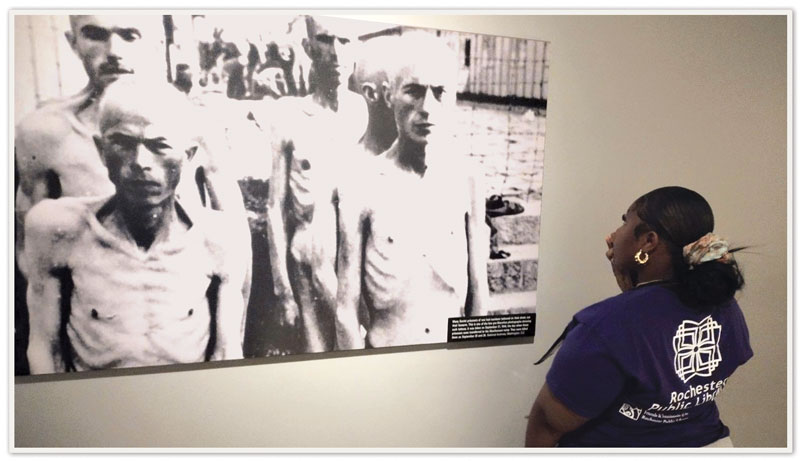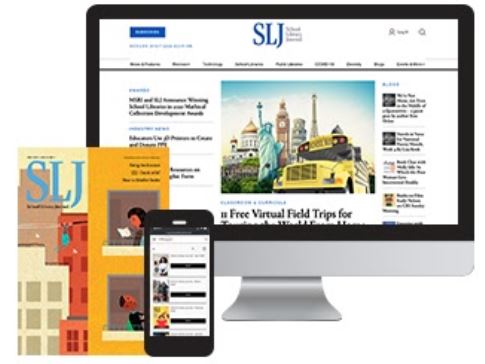Rochester (NY) Public Library Program Takes Teens to Washington, DC
Thanks to a remarkable effort by a public library, 20 New York teens had an unforgettable trip visiting monuments and museums and learning and connecting with history.
 |
George Carter (far right) and teens from RochesterPhotos courtesy of George Carter |
Lamarie Felton thinks about the lights, the “countless dots,” one for every child killed in the Holocaust. The 16-year-old from Rochester, NY, saw the moving and memorable display in an exhibit at the United States Holocaust Memorial Museum in Washington, DC. It’s an experience, Felton says, that she “will carry with me for a lifetime.”
Felton’s experience at the Holocaust Museum was part of a three-day trip to the nation’s capital run by the Rochester Public Library’s (RPL) Safe to Be Smart after-school program in July 2024.
The 20 teen patrons, ages 13–17, and their five adult chaperones also visited the National Museum of African American History and Culture; the White House; the Capitol; the Library of Congress; the Lincoln, Martin Luther King Jr., and WWII veterans memorials; and Howard University on the free trip funded by the Friends & Foundation of the Rochester Public Library with support from the Konar Foundation and Reynolds Library.
For some of the teens, it was the first time they had been outside of Rochester or the surrounding area. For most, it was the first time visiting DC.
The trip was the brainchild of George Carter, Safe to Be Smart supervisor of RPL’s Sully Branch. The Safe to Be Smart program serves more than 800 teens a month, providing counseling and mentoring, along with assistance with homework, résumé writing, and job searches. The program also provides internet access, PlayStation and Wii gaming centers, listening stations, and group programs that include arts and crafts, reading groups, coding groups, history and science discussions, movies, board and card games, cooking classes, and social events. It explores “better ways to educate,” says Carter.
As part of that mission, they sometimes take local field trips. But Carter wanted to do more.
When he proposed the DC trip, he expected criticism for suggesting something so ambitious. But, in a stroke of serendipitous timing, Carter’s supervisor ran into a library benefactor that night and mentioned the idea. He was instantly on board, and Carter moved the idea into action.
Originally scheduled for spring of 2020, the trip was canceled by the pandemic. But Carter wouldn’t let the opportunity be lost, even if it meant starting over to build relationships with new kids and families after those originally intending to go had aged out of the program. This was not a situation where kids could just sign up. It needed to be the right choice for the teen, caregiver, and Carter.
To find the right group, Carter took kids to nearby locations, including the movies and local museums, as well as horseback riding and other events that were already part of the Safe to Be Smart programming. He needed to select the right 20 participants, a task that to be done properly and successfully required building relationships and gaining the trust of their caregivers as well. Everyone had to buy in. In some cases, Carter approved the student and the parent or caregiver said yes, but the student didn’t want to go.
“It’s just got to be a match—everyone saying yes, everyone understanding what I’m asking for; and to be respectful—not just to me, but to themselves and others—to listen. We want to be safe across the board.”
Once selected, the young patrons felt a responsibility to return Carter’s trust, according to Felton.
“We all did play our role of being on the trip and being respectful, not just because we’re going somewhere without our parents, but we’re representing the library, our parents, and we’re representing ourselves,” says Felton.
Norman Rivet, 16, agreed. He said he would have been well-behaved anyway, “but I felt I was upholding respect not only for myself, but also for Mr. Carter, and all the things he’s done for us to get there,” he says.
“They did great,” says Carter. “You know, you have little things where teenagers are going to be teenagers, but for the most part, they were all great. New relationships were built, because some didn’t know each other prior to that. Some of the parents didn’t know each other prior to that, and now, some parents even keep in contact. Some of the students keep in contact. It was just a beautiful experience.”
In addition to the DC landmarks, they toured the campus of HBCU Howard University and spoke with students. For 14-year-old D’Erickah Love-Reed, that stop was the highlight of the trip.
“It was really nice to see how people can come from something very bad and grow into something very important,” she says.
 |
A Rochester teen views a photograph at the U.S. Holocaust Memorial Museum. |
Love-Reed said that, like Felton, she often thinks about the children’s exhibit at the Holocaust museum, which made her want to learn more.
“I would like to like to know more about the children’s side of the Holocaust,” she says. “They didn’t do anything, but they were gassed. They were killed for no reason.”
The Holocaust museum seemed to have the biggest impact on the kids, who, Carter says, knew more about the struggles of the African American community than that of Jewish people. At one point, Carter says, one of the teens had tears in his eyes.
“It’s good that you learn about it and know about it, and know that there’s struggle on all sides and more than what we know,” says Carter.
To help deal with the difficult issues, Carter followed the process he uses for local trips where, for instance, students read about horses before going horseback riding. Before the trip to DC, they prepared by reading and talking about what they would see.
“Some history is not pretty, and it’s going to hurt a little,” says Carter. “But it gives you an understanding of the past and to see how we have grown.”
The group also discussed what they learned when they returned home.
Love-Reed was one of the youngest on the trip and said it was a “really important” experience for her.
“I want to know everything, so I can pass that on to the next generation,” she says, adding that she felt like she now had a more complete view of history and wants to share that with kids who haven’t had the chance to visit those places.
Felton and Rivet appreciated expanding on what they are learning in school and not getting the “sugar-coated” version from a teacher.
“It just showed me a different perspective,” says Felton.
For Rivet, the trip impacted the way he sees things and understands history.
“It really has changed my viewpoint on a lot of history, and a lot of choices made throughout history,” says Rivet. “It has helped me out in school, through my thinking, and just how I view society in general.”
No one took this opportunity for granted, and Rivet hopes that other kids in Rochester, and around the country, are given that chance, too.
“Being able to take kids out of the areas that they’re so used to and expose them to new opportunities and new experiences is a very important thing for kids as they’re growing,” he says.
Carter has been told the trip is “on the table” for funding this year. He believes RPL is the first and only public library in the country to take its young patrons on such a trip, and he would like it to become a regular part of the Safe to Be Smart programming.
“It was just an awesome experience,” says Carter. “And I hope that we’ll be able to do it again.”
RELATED
The job outlook in 2030: Librarians will be in demand
The job outlook in 2030: Librarians will be in demand
ALREADY A SUBSCRIBER? LOG IN
We are currently offering this content for free. Sign up now to activate your personal profile, where you can save articles for future viewing






Add Comment :-
Be the first reader to comment.
Comment Policy:
Comment should not be empty !!!